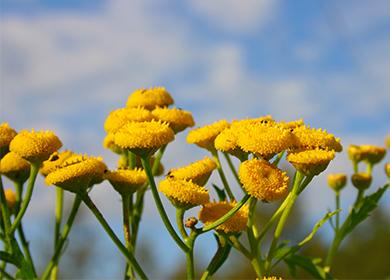The content of the article
The healing properties of tansy are known not only among the people. The healing effect of this plant is recognized by modern scientific medicine. Tansy is listed in the State Pharmacopoeia of Russia, as well as in the pharmaceutical registry of some European countries (for example, in Belgium, Portugal, Finland). It is most often prescribed as a choleretic and anthelmintic agent. The use of tansy grass in folk and traditional medicine is safe if the dosage and doctor's recommendations are followed.
Features of tansy
What diseases of tansy? For agrarians, tansy is a weed, although not the most stubborn. The grass does not form dense thickets, however, if it has settled on a field, in a garden or in a garden, it will grow for a long time and clog other plants. For folk healers, tansy is a valuable medicinal plant, for gourmets - spicy seasoning for dishes.
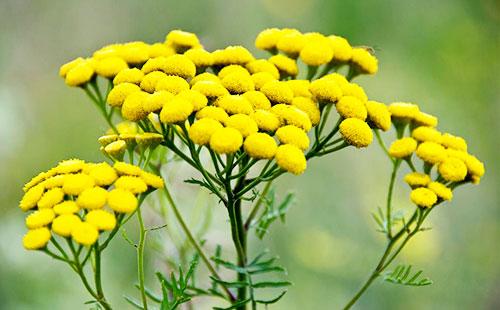
Distribution area and species
The plant has a wide distribution area. It takes root not only in the European part, but also in the Caucasus, the Far East, Siberia, Mongolia, Korea, Japan, China, Central Asia, North America and Africa. He loves meadow landscapes, pastures, steppes, fields, riverbanks, sunny slopes, forest edges and glades of forests, grows along roads and even on personal plots, in gardens. Tansy belongs to the family of asters and has about 70 species, with 30 of them found in Russia. It is noteworthy that a related type of tansy called feverfew, or tansy of a girl’s, is grown as a garden, ornamental plant. Outwardly, it resembles a chamomile. However, recently it has been considered as a medicinal raw material. For example, in England it is often taken for migraines.
Botanical characteristic
The tansy plant is known to many people by its characteristic bright yellow inflorescences, collected in dense shields, as well as by beautiful carved leaves. It is on these grounds that the people call the grass a wild mountain ash. This perennial herbaceous plant can grow up to one and a half meters. It has a lot of straight, branched stems. On the leaves are dotted glands that give the plant a camphorous, pungent odor. However, this smell is saturated not only with leaves, but also with stems, flowers, and rhizome. Tansy blooms for a long time - from July to October.
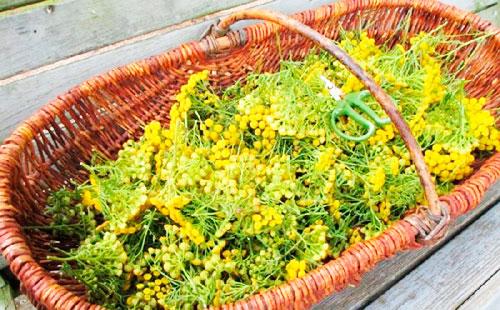
Harvesting raw materials
Common tansy is good in that it can be harvested throughout the summer and autumn during flowering. How is the collection and drying of raw materials?
- Inflorescences can be torn off by hand or cut off with scissors, while peduncles leave about 2 cm long.
- Dried, laying out in a thin layer, on cotton cloth or paper.
- There are several drying options: in a room with good ventilation, outdoors in clear weather, or in electric dryers at a temperature of 40 ° C.
- Tansy flowers are stored separately from other herbs as essential oil raw materials - in a tightly closed container.
- Shelf life of raw materials under proper storage conditions is 3 years.
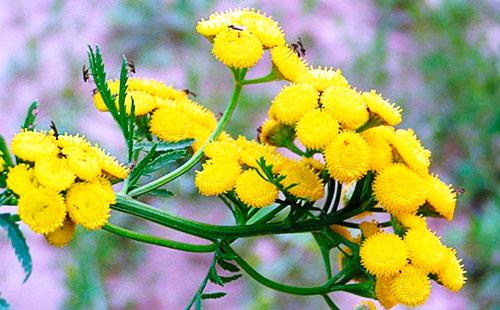
Chemical composition and pharmacological action
Grass refers to toxic, poisonous plants. It contains special organic compounds (sesquiterpene lactones), which in high doses can be hazardous to health. Also thujone, which is contained in the plant, which is a nerve agent, is considered deadly. More toxic varieties of grass grow in arid places and on hills. Therefore, when collecting it, it is recommended to choose shaded places and wet lowlands.
- What is in the composition? In the grass there are many alkaloids, flavonoids, tannins, bitterness, proteins, gums, manganese, glycosides, fatty, essential oils, polysaccharides, organic acids, vitamins. The essential oil includes thujone, pinene, camphor, borneol and other organic compounds.
- What is the spectrum of pharmacological action? Cholagogue, antispasmodic, anthelmintic, antipyretic, anti-inflammatory, diuretic, antimicrobial, wound healing, tonic, analgesic.
There is information that tansy is not as dangerous and toxic as it is described. In Soviet times, an experiment was conducted on cats: animals were given a high dose of tansy solution for a long time. Cats felt fine, no pathologies were found. However, cases of poisoning of livestock that ate grass in large quantities on pastures were recorded.
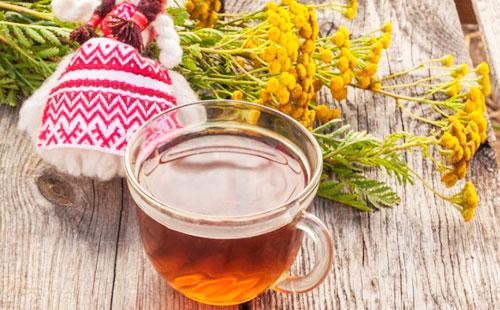
Indications and contraindications
What are the indications for the use of herbs?
- Gastrointestinal tract (GIT) diseases. Tansy helps with liver diseases, stomach cramps, intestines. It is drunk with cholecystitis, hepatitis, gastritis, colitis, flatulence, a stomach ulcer, dysentery. This remedy increases secretion, promotes the separation of bile, increases the acidity of the stomach, normalizes appetite and digestion. Tansy from hemorrhoids is effective, relieves constipation.
- A sedative and sleeping pill. In foreign traditional medicine, the treatment of headaches, insomnia, hysterical, epileptic seizures was practiced. In Russian herbalists there is little information about this action of tansy.
- Bladder and kidney diseases. The grass has a moderate diuretic effect, so it is prescribed for urolithiasis, kidney inflammation.
- Outdoor application. With skin lesions (wounds, ulcers, boils, scabies), gout, rheumatism, bruises, dislocations, apply warm compresses from the decoction of the grass. Tansy relieves swelling and pain. For the treatment of rheumatism, tansy infused with dessert wine is often used.
- As part of a comprehensive treatment for helminthiasis. After identifying parasites, the doctor prescribes various types of drugs. Most often, these are synthetic drugs. But in addition, vegetable fees can be assigned, which include: wormwood, tansy, thyme, fennel, turmeric, walnut, cloves, licorice.
What are the contraindications?
- Pregnancy. Tansy is an absolute and strict taboo for pregnant women. The grass can provoke a miscarriage in the first trimester, cause premature birth in the later stages. For women who are breastfeeding, grass is also contraindicated.
- Children under 14 years old. In some instructions, another figure is found - the medicine is prohibited until 18 years of age. This age limit is associated with plant toxicity.
- Individual intolerance. It manifests itself in the form of an allergic reaction.
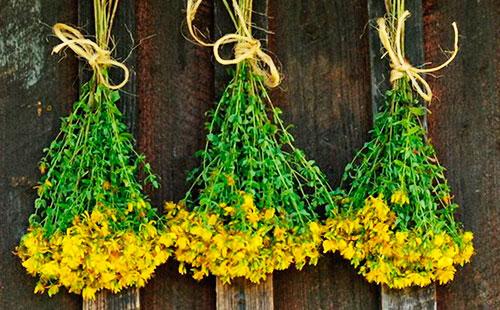
Application in traditional medicine and pharmacology
In ancient Greece, Egypt, Persia, tansy was used to embalm corpses.And among the northern peoples, grass was used as a preservative for animal carcasses. Today tansy is used in the food and chemical industries. It is used as seasoning in England, France, Hungary, Kazakhstan. But in Russia, this plant is still better known as a drug.
How to apply and brew tansy flowers
In the pharmacy you can buy tansy flowers. The instructions for use indicate that the herb can be used as a choleretic and anthelmintic agent. It can also be drunk as a dietary supplement due to the large amount of vitamins and flavonoids; the product normalizes digestion. It is important to comply with the dosage when brewing grass.
Preparation of a decoction of tansy flowers
- Put 1 tbsp. a spoon of grass in enameled dishes.
- Pour a glass of boiling water.
- Hold in a boiling water bath for 15 minutes.
- Cool and strain after 45 minutes.
The resulting broth is diluted with boiled water to a volume of 200 ml. Take 1 tbsp. before meals (15 minutes).

Features of application in gynecology
In gynecology, tansy is used according to strict indications. Not all gynecologists trust this medicinal plant. On professional medical sites, women are urged not to self-medicate with herbal medicine, because the consequences can be the most unpredictable.
- Tansy for abortion. This topic is actively discussed in networks, at various women's forums and medical sites. It is true that grass has abortive properties. But it is also true that tansy for miscarriage at home can result in serious complications. After all, a delay in menstruation can be associated not only with pregnancy, but also with a number of other reasons, primarily due to hormonal failure. There are cases of tansy poisoning, when women take grass in large portions to enhance the effect. The medical point of view is unequivocal: if pregnancy is not desirable for a woman, this issue must be resolved in a medical institution.
- Menstrual irregularities. Tansy for menstruation is taken only after consultation with a gynecologist, when establishing the cause of menstrual irregularities. In ancient herbalists it is mentioned that tansy not only causes menstruation, but also can reduce their profusion.
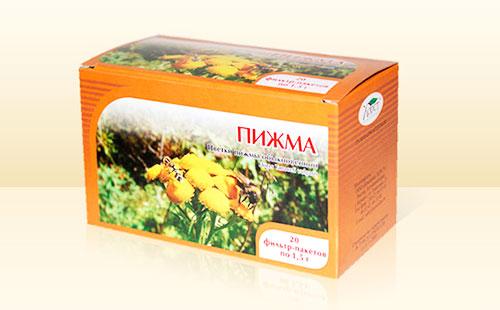
Insecticide
Already mentioned the anthelmintic action of the plant. But due to toxicity, this remedy is not suitable for removing worms in children. The grass is especially effective for pinworms, roundworms and giardia. It can be taken orally and in the form of therapeutic enemas. If opisthorchia is detected in the body, the parasitologist prescribes a comprehensive treatment. Opisthorchiasis is a serious disease with liver damage, which requires long-term therapy, the use of specific anthelmintic agents and the restoration of the digestive tract. Tansy in this case is not enough to get rid of worms.
How to take grass as an anthelmintic medicine?
- Drink ½ cup broth twice a day 15 minutes before meals.
- Treatment is carried out for three days.
- Then on the fourth day they take a laxative.
- If necessary, the treatment is repeated after one to two weeks.
In the treatment of helminthiasis, an increase in the dose of tansy is expected, therefore side effects are possible - nausea, vomiting, dizziness, abdominal cramps. If there is a tendency to hypertension and bradycardia, it is better to avoid taking herbs in high doses.
As an insecticide, tansy is also used to combat ticks, fleas, cockroaches, moths. From it make powder, which is sprinkled on the surface.
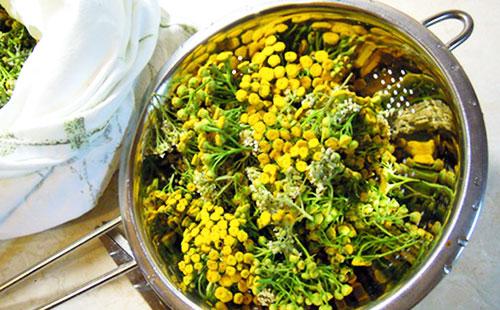
Cosmetology
From the grass, you can prepare decoctions and infusions that wipe problem skin - boils, purulent acne and blackheads, ulcers. Any traumatic damage is treated with this tool. You can also take baths with a decoction of tansy for extensive skin lesions, do rubbing with infusion with sea salt for cellulite. Useful grass for hair. It helps get rid of dandruff.
Cooking hair masks
- Prepare 1 cup of herbal decoction.
- Rub one part of the broth into the scalp before washing.
- Use the other part for final rinsing of already washed hair.
This procedure should be carried out 2 times a week for a month. The broth well removes oily hair, promotes their rapid growth.
Tansy grass is a toxic plant (you can read reviews). This is the first thing you need to remember when starting treatment with decoctions and infusions from it. The second important condition for safe use is medical consultation and the right dosage. First of all, tansy is effective as a choleretic and anthelmintic medicine. Its use in gynecology is a controversial and controversial issue. It must be solved individually with your doctor.
